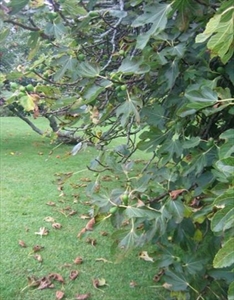Fig rust
Pacific Pests, Pathogens and Weeds - Online edition
Pacific Pests, Pathogens & Weeds
Fig rust (307)
Cerotelium fici; previously known as Kuehneola fici, and Uredo fici.
Asia, Africa, North, South and Central America, the Caribbean, Europe, Oceania. It is recorded from Australia, Fiji, Guam, New Caledonia, New Zealand, Papua New Guinea, Samoa, Solomon Islands, Tonga, Tuvalu, Vanuatu, Wallis & Futuna.
Figs (Ficus species), breadfruit (Artocarpus species), and paper mulberry (Broussonetia papyrifera).
A fungal disease, known as a 'rust', causing early leaf fall. At first a yellow spot on the top surface of the leaves, then small raised spots, or pustules, on the lower surface. They are scattered over the leaves, grouped around the edges, or follow lines taken by dew as it runs across the leaf blade. The pustules also occur on the fruit. When mature, they are pale reddish-brown, circular, 0.5 mm diameter. The spots on the top surface, above the pustules, turn dark, angular, and merge. The leaves yellow and fall.
Spread occurs when spores are splashed short distances from one leaf to another, or between plants; spread over long distances occurs as spores in wind. The spores require water on the leaf surface for germination and infection.
On edible figs, defoliation and yield loss can be significant, and immature fruit fails to ripen.
Look for yellow spots on top surfaces of leaves, later merging and becoming dark and angular. Look for large numbers of tiny (0.5 mm diameter) pustules on the undersides.
CULTURAL CONTROL
A difficult disease to control by cultural techniques once trees become infected. There are different varieties and they should be tested, although none appear to have good tolerance and acceptable market fruit qualities.
- It is importance to reduce the time that leaves are wet to stop spore germination and infection. Do the following:
- Increase air movement in the canopy by regular pruning of branches.
- Avoid overhead irrigation, instead use trickle tape to apply water at soil level.
- Do not plant beneath shade, especially in high rainfall areas.
- Weed to reduce the humidity around the trees.
- Do not plant in areas that flood or where there is free-standing water after rains.
- Ensure trees have adequate nutrition with the application of fertilizer or manures so that new healthy leaves will be produced as quickly as possible after defoliation by the rust disease.
CHEMICAL CONTROL
If fungicides are required use mancozeb or copper. The frequency of application needed to obtain control is not reported, nor are the economics of treatment.
____________________
When using a pesticide, always wear protective clothing and follow the instructions on the product label, such as dosage, timing of application, and pre-harvest interval. Recommendations will vary with the crop and system of cultivation. Expert advice on the most appropriate pesticide to use should always be sought from local agricultural authorities.
AUTHORS Grahame Jackson & Eric McKenzie
Information from Verga A, Nelson S (2014) Fig rust in Hawai'i. College of Tropical Agriculture and Human Resources. University of Hawai'i at Manoa. Honolulu. (https://www.ctahr.hawaii.edu/oc/freepubs/pdf/PD-100.pdf). Photos 1-4 (taken by Eric McKenzie), and used in this fact sheet, appeared previously in McKenzie E (2013) Cerotelium fici PaDIL - (http://www.padil.gov.au).
Produced with support from the Australian Centre for International Agricultural Research under project PC/2010/090: Strengthening integrated crop management research in the Pacific Islands in support of sustainable intensification of high-value crop production, implemented by the University of Queensland and the Secretariat of the Pacific Community.







